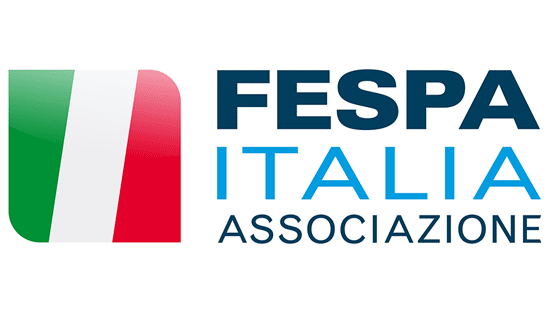Wide format lenticular printing

How the ability to produce eye-catching 3D or ‘moving’ pictures is within reach of ever more printers.
We are all familiar with lenticular printing – whether it was with free rulers given away with breakfast cereal in the 1980s, to contemporary advertising posters found on subway platforms or bus shelters. The person in the street may shrug their shoulders at the mention of lenticular printing, but they know it when they see it.
Lenticular printing, in theory, is fairly simple. Traditionally it uses a plastic or glass lens, underneath which there is the printed artwork that features a numbers of images or frames that have been split into thin slices and sequentially arranged.

Jake Purches, Lenticular Europe
“You divide the images you want to use into lots of lines,” Jake Purches, founder of Lenticular Europe, says. “You then arrange a line from the first image in the sequence, then a line from the next image, then a line from the next and so on, repeating the series with the subsequent lines from each image. We call it interlacing, and you’re effectively weaving different sections from different images into the print. The lens on top shows the viewer just one set of those lines to give one complete image. But as the viewer moves, they see the other complete images, giving either a 3D or a moving effect.”
Bigger is better
In practical terms, the production process appears deceptively easy: the lenticular print is prepared using computer software (such as Humaneyes) to interlace the image; it is printed on a high resolution printer; and then the print is mounted to a compatible clear lens. However, difficulties can occur.
It’s actually a bit easier with large format rather than, say, litho because you tend to be dealing with thicker and bigger lenses
“There are a lot of things that can go wrong, and that tends to put people off,” Jake says. “When I train people, I try to explain that making the lenticular image is actually relatively straightforward – the problems come when trying to understand all the other things that go on: plastics change in dimension with humidity and temperature, and printing presses are never very linear. All these things conspire to really make a bad lenticular print even though the actual image may be fine.
“It’s actually a bit easier with large format rather than, say, litho because you tend to be dealing with thicker and bigger lenses that don’t change shape so easily because of environmental factors. Also, usually you’re dealing with just one printer rather than six or seven stations that are all slightly out. And you can redo it. With large format, you just print, stick a lens on it and see if it works. If it does, that’s great. If not, adjust and it’s easy and cheap to try again. Your capital outlay in that case is just one print and one lens sheet, which might be £20 to £100 depending on size.”
Jake says: “Flip lenticulars usually suffer around 5% ghosting when they are front lit. This is due to defraction effects in the plastic itself and can be mitigated by choosing lower contrast images or graphics – colours are good, black and white is not good. So when white text is required to disappear, it works better if it’s a tone of light grey, or blue. Back lit (lightbox) lenticulars often lose the ghosting entirely.”
Twenty years of lenticular technical advances
With more than 20 years specialising in lenticular printing, Jake has seen the associated technology develop at first hand. He says two things have made lenticular easier and higher quality: better computers and more accurate printers.
“I started in 1998 but there was practically no information about lenticular, other than a couple of companies who were doing it,” Jake says.
“Over the course of a year, I did a lot of experiments and gradually got something working. Although I initially did a lot of litho lenticular prints, that was also around the time that large format digital printing became a reality, so really, it got moving when the technology matured.
“As the computers became faster, things got better. Although it was possible to prepare lenticulars on ordinary computers, it was terribly slow in the early days. Now it takes just seconds. Perhaps most importantly, there’s a lot more software now that you can use to prepare lenticulars without necessarily having to understand exactly what’s going on, which opens it up to a lot more people.
Software choices
What software does Jake use? “Personally, I use 'Lenticulator' from Henri Clement, which is French software, and the production mostly done in Photoshop. However there are other packages, and a good one is a Russian system called Triaxes. Both systems cost around 600 to 1000 euros.
“Lenticular imaging isn't something that can be picked up and be mastered in a few hours – it requires a lot of work and the best printers are the ones who learn from their mistakes. It is not for everyone, and it’s not for those who think its a quick road to riches. However for those who are consistent and persistent, it can pay off quite well. For myself after 23 years of making them, I still get expensive rejects. But as time goes by the rejects get fewer and fewer. The beginning is often frustrating if you're trying on your own.”
Can training courses be advantageous in bringing printers up to speed? Jake says: “There are two avenues – the lenticular image production and the printing stage. Both have their own skills to learn. It can be divided, so graphic designers can learn the mastering skills and printers can learn the printing skills required. I offer training in both, and usually it’s a five-day course at £5,000 for onsite training and technical support after.
“Improvements to printers have made lenticular easier, too. You need high-quality, high-resolution print to achieve the necessary quality that allows accurate reproduction of the interlaced lines. It’s important to run a line length accuracy test. With modern inkjet machines that’s quite easy and they have more than enough resolution.”
Practicalities and plastics
So how big can you go with lenticular prints? The biggest lens sheet currently available is 6ft x 4ft (1.8m x 1.2m), and because these lenses are fairly uniform, they can be joined together.
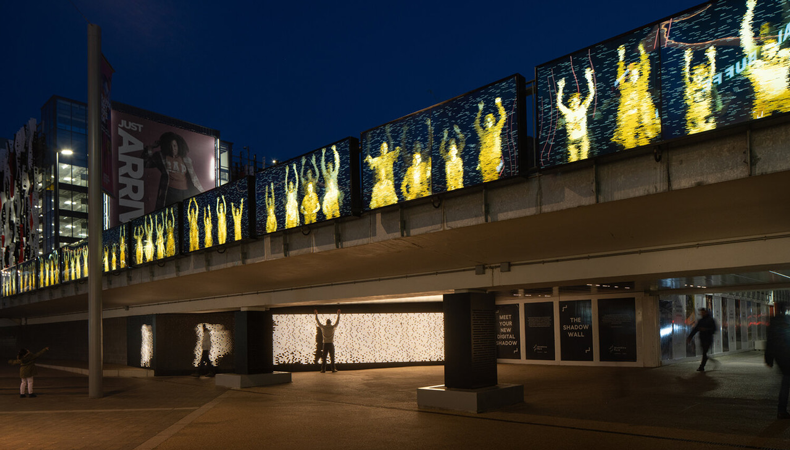
The Shadow Wall lenticular installation in London
“I’ve done wall size prints and big exhibition panels, and with laser cutting you can get things to fit nicely,” says Jake. “I’ve just done a 100-metre lenticular installation for a bridge at Wembley stadium in London with a ‘Mexican Wave’ kind of effect.”
Regarding the cost, the plastic lenses form a large proportion of the product cost. A single 6ft x 4ft large format lenses at 20 lens per inch (LPI) is about £100, although prices depend on the sheet thickness as well – the thinner it is, the less plastic and the cheaper the cost.
“As well as the more traditional laminated approach, I’ve also been doing some work recently using flatbed large format inkjet machines, where you print directly onto the back of the lens,” says Jake. “It works, you can get good 3D and the quality is sufficient for most things, such as point of sale – but for fine art work it’s not quite high enough yet.
“However, direct printing has the advantage that you won’t get any dust trapped in the laminating process and it’s also quick if you are doing long runs. The disadvantages are that you can’t see whether it’s right until you’re finished – because it’s printing upside down – and if it’s wrong you’ve got to throw it away. With a laminated print you could just pull it apart, clean the lens sheet down and start again. So, you’ve got to be more careful and do lots of test set-ups to make sure it’s right.”
A new approach
As well as printing direct to the lens, other companies are looking at new ways of creating some of the same effects as lenticular by printing the image to clear substrate and then effectively 'printing' the lens on top, such as the technique used by Midi Print in Russia.
Other companies even avoid the use of clear substrates entirely. For example, swissQprint has developed its ‘droptix’ technology, which effectively prints the lenses needed to produce 3D effects with transparent liquid varnish.
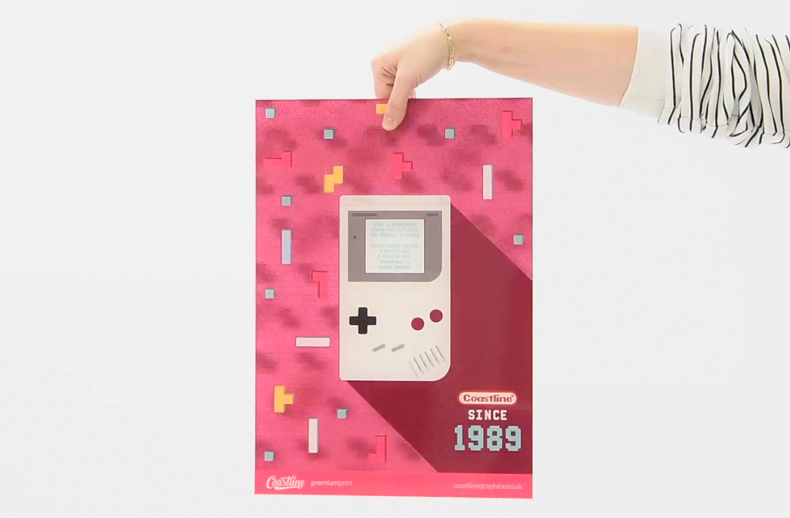
Swiss Q Droptix
“With droptix there is no need for any expensive extruded plastic substrates,” says Kilian Hintermann, Head of the Print Solutions Centre. “Instead, you can use standard acrylic sheets or similar transparent media up to 15mm thick. That also means that the only thing limiting the dimensions of image you can produce is the size of the print table.”
To make the system easier to use, swissQprint has created its proprietary Kea software, which helps to design the correct print pattern to create the 3D effects. There are some requirements, though. Users need familiarity with Adobe Illustrator to create the artwork and the system is only compatible with swissQdesign’s own printers – including the wide format Nyala model that can print images up to 2m x 3.2m – which require a varnish channel and a white channel to be fitted.
“The pattern needs to be printed in high resolution and quality, and to create the 3D, we use the same varnish that is used for regular gloss effects. It takes accurate three-point registration to the fit the pattern one side and the lenses on the opposite side, but that is guaranteed by the swissQprint registration pin system,” Kilian says.
I think people see video all the time and it doesn’t really impress them, but with lenticular there’s a sort of strange element
“The printing process of the pattern and the lenses is straightforward and does not take any special training. In terms of time, printing 2m x 1m would take approximately 25 minutes to complete. In fact, probably the most important issue when using droptix is the skills of the pre-press user, although experienced staff can do it in minutes.”
A lenticular future?
With lenticular printing effects becoming simpler and cheaper, the future for lenticular looks especially bright, even despite the threat from more technologically complex alternatives.
“We thought that when video displays got better and cheaper, people wouldn’t want lenticular, but that hasn’t actually been the case,” Jake at Lenticular Europe says.
“I think people see video all the time and it doesn’t really impress them, but with lenticular there’s a sort of strange element. It grabs people’s attention and whether it’s a zoom, flip or 3D effect it always offers an element of surprise.
“So, I think it’s something that has a good future. For printers, it can add a lot of value to the basic components, and you can make a significant profit margin above what you would make selling just a basic print. Of course, do you need experience to get it right. But if people are patient to learn it and master it – and a lot of people have – then it’s something that’s well worth looking into.”
Become a FESPA member to continue reading
To read more and access exclusive content on the Club FESPA portal, please contact your Local Association. If you are not a current member, please enquire here. If there is no FESPA Association in your country, you can join FESPA Direct. Once you become a FESPA member, you can gain access to the Club FESPA Portal.
Topics
Recent news

How AI can benefit your data collection
Printers are collecting data about everything from costs to customers and inventory. But how can AI help you to make the most of that?
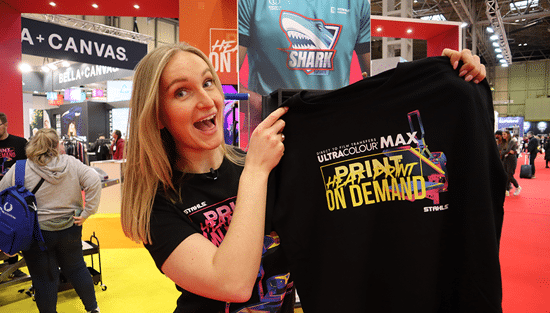
No minimum order: the growth of DTF decoration
Andy Rogers at Stahls’ UK and Europe, garment decoration firm based in Braintree, UK and Dillingen, Germany, on the cost and speed benefits of direct to film (DTF) printing.
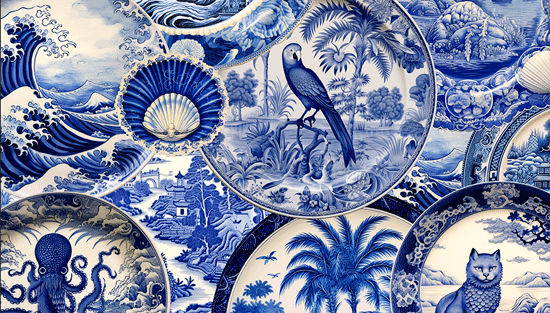
The design democracy: AI, creativity and interior décor
We spoke to Matt Fletcher of John Mark Ltd and Cheryl O’Meara from the Print Pattern Archive about combining age-old techniques with artificial intelligence (AI) to create exciting new motifs for luxury wall coverings.
